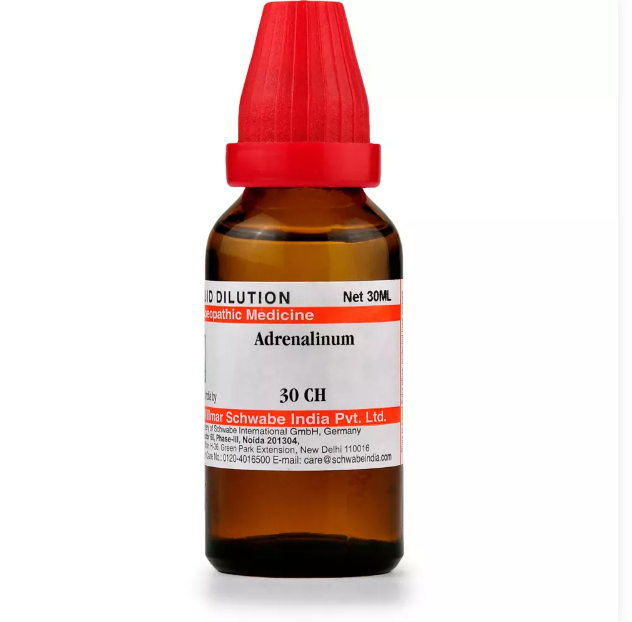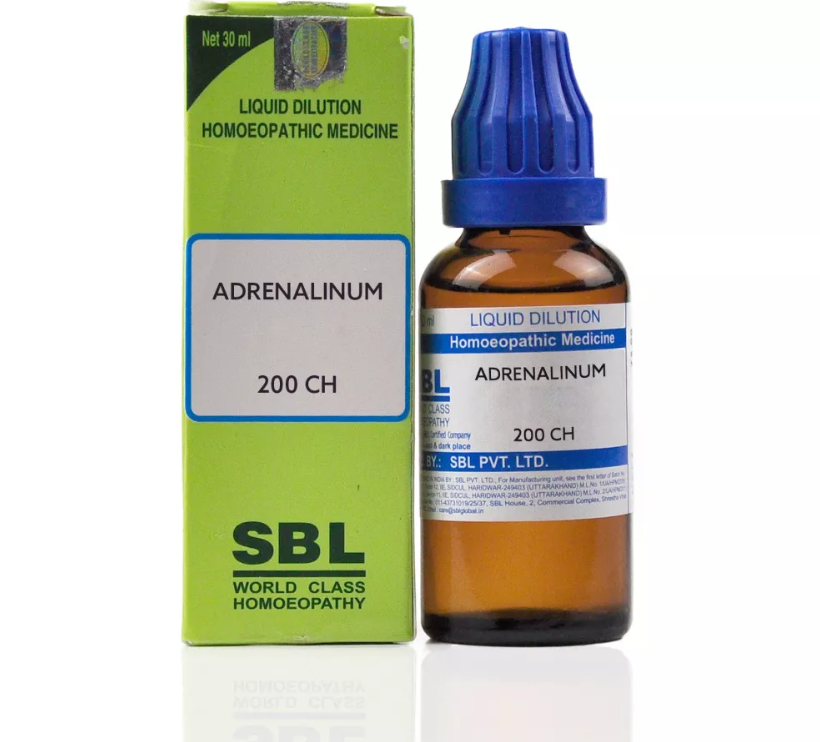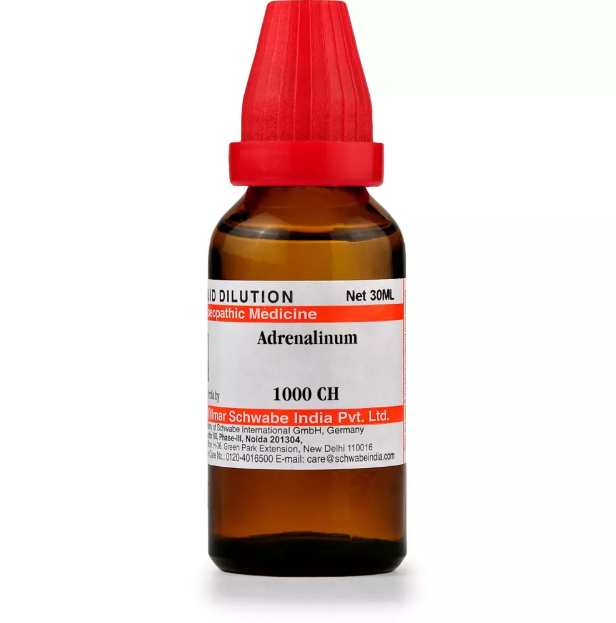ADRENALINUM 6C, 12C, 30C, 200C, 1M, 10M USES AND SYMPTOMS
 ADRENALINUM
ADRENALINUM
(Secretion from Suprarenal Glands)
Adren.
Adrenalin or Epinephrin, the active essence found in the medulla of the suprarenal gland, serves as a vital messenger in regulating body functions. It plays a crucial role in activating sympathetic nerves. When applied locally (1:1,000 solution) on mucous membranes, it swiftly induces brief ischemia, visible as temporary blanching, persisting for hours after conjunctival instillation. Its action is rapid, effective, and short-lived, primarily due to swift oxidation, posing minimal risk unless excessively repeated, as seen in atheroma and myocardial heart lesions (as reported in animals). It notably affects arteries, heart, suprarenal bodies, and the vasomotor system.
The primary effect of Adrenalinum is the stimulation of sympathetic nerve endings, especially in the splanchnic area, leading to constriction of peripheral arterioles and a subsequent rise in blood pressure. This effect is prominent in the stomach and intestines, less so in the uterus and skin, and negligible in the brain and lungs. Additionally, it decelerates the pulse (medullary vagus stimulation), fortifies the heart beat (increased myocardial contractility, akin to Dig.), boosts glandular activity, induces glycosuria, depresses the respiratory center, causes contraction in the eye and reproductive organs, and relaxation in the muscular tissues of the stomach, intestines, and bladder.
Uses: Its primary therapeutic application relies on its vasoconstrictive action, making it a potent and rapid astringent and hemostatic agent. It proves invaluable in controlling capillary hemorrhages from various parts, where local or direct application is feasible, such as the nose, ear, mouth, throat, larynx, stomach, rectum, uterus, and bladder. It can induce complete bloodlessness (ischemia) with minimal risk. Locally, solutions (1:10,000-1:1,000) sprayed or applied with cotton have proven highly effective in bloodless operations involving the eye, nose, throat, and larynx.
Congestions in the ethmoidal and sphenoidal sinuses, as well as hay fever, have shown marked improvement with a warm spray of Adrenalin chloride (1:5,000). For enhanced drainage, compare with Hep. 1x. Werlhoff’s disease can be treated hypodermically (1:1,000). Externally, it has found application in various conditions like neuritis, neuralgias, reflex pains, gout, rheumatism, using an ointment of 1-2 m. from a (1:1,000) solution along the nerve trunk.
Therapeutically, Adrenalinum has been proposed for acute lung congestion, asthma, Grave’s and Addison’s diseases, arteriosclerosis, chronic aortitis, angina pectoris, hemophilia, chlorosis, hay fever, serum rashes, acute urticaria, etc. Dr. P. Jousset reports success in homeopathic treatment, particularly in cases of angina and aortitis, sub-acute and chronic. Symptoms guiding its use include a sensation of thoracic constriction with anxiety, accompanied by vertigo, nausea, and vomiting. Abdominal pain and a prompt rise in blood pressure during anesthesia address shock or heart failure.
Dose: Hypodermically, administer 1-5 m. (1:1,000 solution, as chloride) diluted in water. Internally, use 5-30 m. of 1:1,000 solution.
Caution: Due to its oxygen affinity, the drug easily decomposes in watery and dilute acid solutions. Protect the solution from air and light. Avoid frequent repetition, considering potential cardiac and arterial lesions. For homeopathic use, employ 2x to 6x attenuation.
SYMPTOMS OF Abrotanum
 Stimulation of Sympathetic Nervous System:
Stimulation of Sympathetic Nervous System:- Stimulation of sympathetic nerve endings, especially in the splanchnic area.
- Constriction of peripheral arterioles, leading to a rise in blood pressure.
Local Effects:
- Swift induction of brief ischemia (temporary blanching) when applied locally on mucous membranes.
- Persistence of ischemic effect for several hours after conjunctival instillation.
Cardiovascular Effects:
- Deceleration of the pulse due to medullary vagus stimulation.
- Strengthening of the heart beat through increased myocardial contractility, resembling Digoxin’s action.
Glandular and Metabolic Effects:
- Increased glandular activity.
- Induction of glycosuria.
Respiratory Effects:
- Depression of the respiratory center.
Muscular Effects:
- Contraction of muscular tissue in the eye, uterus, and vagina.
- Relaxation of muscular tissue in the stomach, intestines, and bladder.
Therapeutic Uses:
- Vasoconstrictive action leading to potent and rapid astringent and hemostatic effects.
- Control of capillary hemorrhages in various body parts, such as nose, ear, mouth, throat, larynx, stomach, rectum, uterus, and bladder.
- Induction of complete bloodlessness (ischemia) in a controlled manner.
Local Applications:
- Highly efficient in bloodless operations of the eye, nose, throat, and larynx when applied locally in specific solutions (1:10,000-1:1,000).
Respiratory and Sinus Conditions:
- Marked alleviation of congestions in ethmoidal and sphenoidal sinuses, as well as hay fever, with a warm spray of Adrenalin chloride (1:5,000).
External Applications:
- Use in conditions such as neuritis, neuralgias, reflex pains, gout, and rheumatism, through external application along nerve trunks.
selection of the potency
Individualization:
- Homeopathy is based on the principle of treating the individual, not just the disease. The unique symptoms and characteristics of the person are crucial in determining the most suitable potency.
Intensity of Symptoms:
- The intensity of the symptoms guides the choice of potency. If the symptoms are intense and acute, a lower potency (e.g., 6C, 30C) might be considered. For chronic conditions with less intensity, higher potencies (e.g., 200C, 1M) may be appropriate.
Sensitivity of the Patient:
- Some individuals are more sensitive to homeopathic remedies, while others may require higher potencies. The practitioner considers the patient’s sensitivity when selecting the potency.
Acute vs. Chronic Conditions:
- Lower potencies are often used for acute conditions, while higher potencies may be considered for chronic or long-standing issues.
Previous Response to Potencies:
- The patient’s response to previous homeopathic treatments helps guide the choice of potency. If a particular potency has been effective in the past, it may be repeated or adjusted as needed.
Vital Force and Susceptibility:
- Homeopathy views illness as a disturbance in the vital force. The practitioner assesses the patient’s overall vitality and susceptibility to determine the appropriate potency.
Aggravation or Amelioration:
- The direction of the symptom response (aggravation or amelioration) after taking a remedy can influence the choice of potency.
Miasmatic Considerations:
- In classical homeopathy, the concept of miasms (inherited disease tendencies) is considered. The practitioner take this into account when selecting the potency.
Practitioner Experience:
- The experience and preference of the homeopathic practitioner play a role. Some practitioners may have success with certain potencies based on their clinical experience.
SAFETY INFORMATION
- Do not exceed the recommended dose by physician
- Keep out of the reach of children
- Store in a cool dry place away from direct sunlight
- Maintain half an hour gap between food/drink/any other medicines and homoeopathic medicine
- Avoid any strong smell in the mouth while taking medicine e.g. camphor, garlic, onion, coffee, hing
Medicine images use for reference only selection of homeopathic medicine depends on the individual’s specific symptoms and overall constitution. Moreover, homeopathy is a holistic system of medicine that treats the individual as a whole. In addition to addressing the physical symptoms, it takes into account the emotional and mental state of the person. Consequently, it’s crucial to consult with a qualified homeopathic practitioner for personalized treatment.
The information provided on this website is intended solely for educational purposes. Always seek the advice of your physician or other qualified health provider.
